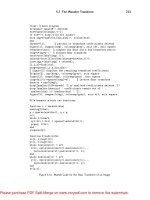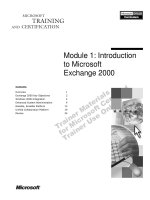INTRODUCTION TO BREWING AT FULLERS docx
Bạn đang xem bản rút gọn của tài liệu. Xem và tải ngay bản đầy đủ của tài liệu tại đây (136.89 KB, 46 trang )
1
INTRODUCTION TO
BREWING AT
FULLERS
2
CONTENTS
BREWHOUSE 5
• Brewing Liquor 6
• Raw Materials 7
• Milling 8
• Mashing 9
• Extract 12
• Starch Degradation 13
• Wort separation 15
•Hops 16
• Wort Boiling 18
• Wort Clarification
& Cooling 19
• Wort Analysis
Examples 20
FERMENTATION 21
• Carbohydrate
Metabolism 23
• Nitrogen
Metabolism 24
• Fermentation
Profiles 25
• END PROCESSING 27
• Beer Conditioning 28
• Cask Beer 30
• Conditioning / Racking
• Tank 32
• Filtration Aids 33
•Filtration 34
• Bright Beer Tank 36
• Small Pack Quality
Control 39
• Bottling 40
• Canning 42
• Pasteurisation 44
• Kegging 47
• End Processing Food
Safety 48
C. I .P 49
RECOMMENDED
READING 51
3
MALT
SILO
FLASH PASTEURISER
BOTTLES / CANS
OR
KEGS
FERMENTATION
THE BREWING PROCESS
BREWING
LIQUOR
MASH TUN
COPPER
/ WHIRL
POOL
MILL
SWEET WORT
CONDITIONING
TANKS
MATURATION
TANKS
CASKS
RACKING
TANKS
PARAFLOW
BRIGHT BEER
TANKS
4
The Brewing Process
• MILLING - malted barley is crushed to form a coarse
flour called grist
• MASHING - grist is added to liquor to form a porridge-like
mash. This activates the enzymes, thus enabling them to
solubilise the protein and starch fractions of the
endosperm
• WORT SEPARATION-the aqueous extract, called wort,
is separated from the spent solids using a mash tun
• WORT BOILING - the wort is boiled in the presence of
hops which impart bitterness and aroma. Boiling sterilises
the wort, coagulates some proteins and causes formation
of colour compounds. The spent hop material along with
some protein, known as trub, is removed by whirlpool
action.
• FERMENTATION - the wort is then cooled to 17°C and
transported to the fermentation vessel. The wort is
aerated & pitched with yeast. Fermentation proceeds
until much of the carbohydrate is converted to alcohol
and carbon dioxide. Higher alcohols and other yeast
metabolites (for example esters) contribute to beer
flavour and aroma.
• END PROCESSING - beer is then conditioned to modify
the flavour and aroma before clarifying. All beer
characteristics are checked and adjusted to within
specification. The beer is packaged into cask or filtered
and pasteurising before being packaged into keg, bottle
or can.
5
BREWHOUSE
6
Brewing Liquor
• Water Treatment - removal of hardness by heating & acid
addition
• Direct Flavour Effects - Na
+
sweet (salty in excess) / Mg
2+
bitter, sour / Fe
3+
metallic / Cl
-
fullness / S0
4
2-
astringency /
K+ salty
• Indirect flavour effects - yeast requirements / pH / enzymes
during mashing Keep calcium >150ppm. Four times more
calcium than malt oxalate required
pH CONTROL
• Bicarbonate more influential at raising pH than calcium at
lowering
• Carbonate : bicarbonate buffer system
Ca
2+
H
2
0 + CO
2
HCO3- CO
3
2-
CaCO
3
• Calcium : malt buffering system
3 Ca
2+
+ 2 HPO
4
2-
2H
+
+ Ca
3
(PO
4
)2
Polypeptide H + Ca
2+
Polypeptide Ca + 2 H+
• High bicarbonate high wort pH due to removal of H+
• Calcium reacts with malt protein to reduce wort pH /
increased run-off rate / increased extract recovery / increased
TSN & FAN / precipitation of oxalate
7
Raw Materials
Pale Ale Malt
• Malted barley
• Concentrated source of starch
• Starch consists of unbranched helical amylose [200-
400 D-glucose units linked via α−1,4-positions] AND
branched amylopectin [D-glucose units linked via α-
1,6 and α -1,4 links. Up to 6000 glucose units]
molecules.
• Barley starch granules : large granules supply most of
the brewers extract (20 - 25µ) and small starch
granules (1 - 5µ)
• Barley protein : 30% glutelin (dissolves in weak
alkali)+ 37% hordein (dissolves in 80% alcohol)+ 11%
albumin (dissolves in water)
• High molecular weight proteins : improve head
retention
• Low molecular weight proteins : amino acids and small
peptones for fermentation are haze precursors
• Fats : husk and aleurone layer e.g. stearic acid, oleic
acid, linoleic acids = long chain fatty acids. Detrimental
to beer foam, but required for membrane synthesis.
8
Raw Materials
Coloured Malts & Adjuncts
• Crystal Malt - contributes colour (150° EBC colour
units)and malty / nutty / toffee / fruity notes to
London Pride, Chiswick Bitter & ESB
• Chocolate Malt - contributes colour & flavour to
London Porter
• Amber Malt - contirbutes colour (45°EBC colour
units) and sweetness and dryness to 1845
• Malted Wheat - contributes fullness and fruity notes
to Summer Ale along with more protein for head
formation
9
Milling
Mechanical breakdown of dry goods to produce grist.
Preparation of grist for the mash tun
Keep husk material in-tact to act as filter bed during
wort recovery
• Endosperm material into small particles, grits,
which readily hydrate during mashing to reactivate
the malt enzymes giving us maximum extract.
• Dry milling - 4 roller mills with 2 pairs of contra-
rotating rollers.
• Proportions of coarse grits (0.3mm-0.6mm
diameter):fine grits (0.15mm - 0.3mm): flour
(<0.15mm) ratios vary from 27:35:38 to 24:35:41
• Gypsum (calcium sulphate) is added to the grist as
it is produced (see liquor treatment page)
• Grist transferred via conveyor to grist hoppers
above mash tuns
10
Mashing
Hydrate grist and activate enzymes to form
soluble substances for fermentation
• Hot liquor (69°-71°C) comes into contact with
the grist in the ‘Steels Masher’ to achieve a
mash temperature of 65°C in the mash tun
• A porridge-like mash is formed with a bed
depth of 1.5-2.0m in the mash tun
• The mash tun has a false / slotted floor 5mm
from the base of the vessel and the mash sits
on this for 55mins. The false floor is flooded
with hot liquor before mashing starts to
remove the air
• During this period starch is degraded by
amyloytic enzymes forming sugars (primarily
maltose) and protein is further degraded by
proteases. The cell wall material is also further
degraded by glucanases
• Important flavour developments occur during
mashing as a result of the starch degradation
11
Mashing Enzymes
ENZYME ACTION OPT.
pH
OPT.
TEMP
Protease Hydrolysis of proteins
to amino acids
-52°C
Beta -
Glucanase
Breaks gummy beta-
glucans into shorter
chains
-60°C
Beta –
Amylase
Attacks reducing end
of starch to give
maltose
5.4 62°C
Alpha –
Amylase
Random hydrolysis of
starch to form
dextrins
5.7 67°C
12
Extract -L°/Kg and %
w/w
• EXTRACT - amount of substances in solution
from raw materials under controlled conditions
(IOB L°/Kg or EBC %w/w)
• %w/w sucrose = °Plato or °Brix (approximately
SG ÷ 4)
• Determining extract (malts) small scale mash
50g in 515 ml solution & measure °excess
gravity
L°/Kg = 10.13 x °excess gravity
°excess gravity = L° / 10.13
%w/w sucrose = 0.2601 x L° - 0.364
L°/Kg = 3.845 x % w/w sucrose + 1.178
13
Starch Degradation
• Gelatinisation - starch granules swell with water
and finally burst viscous/sticky solution which can
be directly attacked by enzymes.
• Liquefication - rapid reduction of viscosity by α-
amylase attacking gelatinised amylose and
amylopectin
• Saccharification - α-amylase continues random
attacks and β-amylase attacks new non-reducing
ends to form maltose
IODINE TEST
• Blue = gelatinised starch / large dextrin's
• Violet / Red = Medium size dextrins
• Iodine normal = small dextrins / maltotriose /
maltose / glucose
14
Wort Separation
The sugar solution, wort, is separated from the grains
• Filtration process with the husk as the filter bed
• Recirculation - bed settling and wort clarification
• 1st stage - first wort or strong wort collection (high in
extract)
• 2nd stage - sparging the spent grain with liquor to
remove extract
• Last runnings - 1004° (0.5°P). Leave polyphenolic &
tannin material from husks
• Spent grains - 70% water[28% protein; 8.2% fat;
41% N-free extract; 17.5% cellulose; 5.3% inorganic
material].
• Extract recovery 98-100%
• Turn around time 3 hours.
15
Hops - Humulus lupulus
The Hop Plant
• Perennial, dioecious climbing plant belonging to
the Cannabis family; only female plant bears hop
cones
• Grown in temperate climates eg. UK, NZ, North
USA
• Hop cone (or flower) contains 14 - 21% hop resin
which houses the α-acids (humulone; cohumulone;
adhumulone) which are needed by the brewer
• Hop cone contains 0.5-1.5% essential hop oils
which give beer its characteristic hoppy aroma
• Hop pellets are concentrated from hop cones and
used at Fullers
• Different hop varieties offer different characteristics
to the beer eg. floral, spicy, woody, citrus notes
• Some varieties used at Fullers include Target,
Northdown, Challenger, Goldings all grown in the
UK
16
Hops
Hop Chemistry
• The α-acids are isomerised (chemically changed)
during wort boiling to give iso-α-acids (isohumulone;
isocohumulone; isoadhumulone)
Use Of Hops
• Kettle hopping - added at the start of the boil to
covert the non-bitter α-acids to bitter iso-α-acids
• Late Hopping - aroma hops added late to boil /
remaining oils give late hop characters
• Dry hopping - addition of hop cones directly to the
cask during racking
17
Wort Boiling
• Traditionally a copper vessel used
• Now we have two 520 HL stainless steel coppers
where the wort is boiled
• The wort is continuously pumped from the vessel to
an external calandria (called the EWB=external wort
boiler) for heating & returned to the vessel
tangenitially (at 90°)
Chemisty
• Formation of bitter compounds
• Wort sterilisation
• Precipitation of calcium phosphate & proteins
causing the pH to drop from 5.4 to pH 5.2
• Evaporation and hence concentrate the wort
• Inactivation of enzymes
• Formation of flavour active compounds
• Formation of colour compounds
• Protein & tannin coagulation which is removed as
trub from the base of the vessel after the whirlpool
sequence
• Removal of undesirable volatiles
18
Whirlpool
This is a method of separating the hot boiled wort from
the trub
• After the boil is complete the wort iwe continue to
pump the wort from the base of the vessel and
return at relatively high speeds tangentially (<5m/s)
into the vessel, this creates a ‘spinning’ action in the
vessel.
• The wort pumping is stopped, and the wort is
allowed to spin freely for 20 minute.
• As it loosses momentum the heavier ‘trub’ material
settles in the trough at the base of the copper
• Trub material is composed of hop materail which
protein, polyphenol & tannins have become adhered
• When the wort is run-off for cooling and pumping to
fermentaion vessel it is drawn through a pipe above
the trough so the trub is left as a waste material
• Longer stands allow more SMM (sulphur methyl
methionine) from malt to be converted to DMS
(dimethyl sulphide) a strong flavour compound (50-
60ug taste threshold) % DMSO (dimethyl
sulphoside). Most DMS formed and lost due to its
volatility during wort boiling.
19
Wort Cooling
Quick cooling of the wort via a paraflow
• This cooling removes the cold break (small
particles (<0.5um) of protein/ polyphenol / hop) and
prepares the wort ready for yeast addition.
• The paraflow is a heat exchanger made up of 100
plates with chilled liquor (<10°C) on one side and
hot wort on the other.
• This large surface area allows the heat from the
wort to heat up the liquor (thus cooling the wort
itself) which returns to the liquor tanks for the next
day brewing.
• The wort is cooled to 17°C ‘en route’ to the
fermentation vessel
20
FERMENTATION
21
Fermentation
Conversion of wort sugars to form alcohol & other
flavour components
100 g Maltose + 0.5 g Amino acid 5 g Yeast +48.8 g
Ethanol +46.8 g CO
2
+ 50kCal Energy
• Wort is made up of 70% Maltose; Maltotriose 18%;
Sucrose 5%; Glucose 5%; Fructose 2%
• Pitching (adding) viable yeast at 10 million cells per ml is
added to the wort from the paraflow to the fermentation
vessel
• Air is added in-line or directly into fermentation vessel at
the start of fermentation this is so the yeast can for
materials needed for new cell membranes & walls
• The air is switched off and anaerobic metabolism by the
yeast of the wort sugars continues to form alcohol &
carbon dioxide
• Initial lag phase then exponential growth until alcohol &
lack of energy source limits growth
• pH decreases from pH 5.0-4.9 during fermentation due to
formation of organic acids / uptake of ammonium ions
NH4
-
/ release of H+ ions
• Diminishing food supply & increasing ethanol - yeast
cannot tolerate so growth subsides after 3-4 days
22
Carbohydrate
Metabolism
• Sequence of sugar uptake :(a) glucose, fructose, sucrose
(b) maltose (c) maltotriose
• Anaerobic respiration via the glycolytic or Embden -
Meyerhof Parnas pathway
• A small proportion of acetyl Coenzyme A is formed
during the fermentation from pyruvate via the TCA cycle.
TCA cycle also yields oxo acids & NAD. Acetyl Co A is
important in production of fats & esters and amino acid
synthesis.
• Without oxygen, fatty acids & sterols can not be
synthesised to form membranes & yeast can not tolerate
the ethanol concentration so growth ceases.
• Acetyl CoA + alcohol ester + Co A
e.g. Acetyl CoA + ethanol ethyl acetate + Co A
Palmityl CoA + glycerol glycerol tripalitate (a fat) +
Co A
• Higher alcohol production from carbohydrate metabolism
(via pyruvic or oxaglutaric acid) or nitrogen metabolism
23
Nitrogen Metabolism
• Amino acids in wort used for protein synthesis / DNA &
other cellular structures
• Arginine; aspartic acid; asparagine; glutamic acid;
glutamine, lysine; serine; threonine can be used only at
start of fermentation. Other amino acids are made by the
yeast cell. During this production the equivalent amount of
oxo acid is made by the glycoltic pathway to accept NH
2
.
• Nitrogen deficiency but oxo acid production continues.
Reduced to alcohol.
• Production Of Flavour Compounds
• Amino acid deamination (removal of amino NH
2
group)
and decarboxylation (removal of CO
2
) higher alcohols are
formed
e.g. leucine pentanol + ammonia + CO
2
• intermediate products are aldehydes which are also
flavour active
e.g. valine oxovalerate isobutyraldehyde
isobutanol
• Acetolactate is decarboxylated then chemically oxidised to
form diacetyl (undesirable butter flavour). Yeast is capable
of reducing diacetyl to 2,3- butanediol which is flavourless
at concentrations found in beer. At the end of fermentation
a warm conditioning period takes place to allow the yeast
to carry out the reduction process.
FERMENTATION PROFILES
0
2
4
6
8
10
12
024681012
DAYS
GRAVITY
°
PLATO
0
10
20
30
40
50
60
70
Y E A S T C E L L C O U N T S m illio n ce lls p e r m l
GRAVITY
pH
YEAST COUNT
Fermentation
SUGARS
PYRUVATE
ACETYL CoA
ACETOLACTATE
DIACETYL
ISO BUTANOL
AMINO ACIDS
SULPHATE
KETO ACIDS
PENTANE
DIONE
SO
2
& H
2
S
FATTY ACYL CoA
LIPIDS
FATTY ACIDS
HIGHER
ALCOHOLS
ESTERS
ACETALDEHYDE
ETOH









